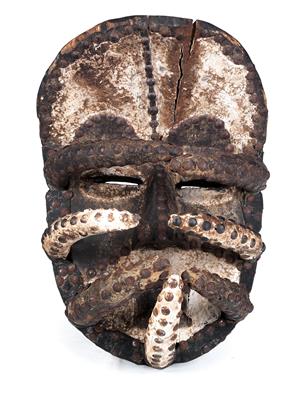Bete or Ngere, Ivory Coast: a rare and unusual mask type, with seven curved spikes that protrude from the bottom edge of the mask.
Bete or Ngere, Ivory Coast: a rare and unusual mask type, with seven curved spikes that protrude from the bottom edge of the mask.

A very exceptional mask of the Bete (probably also to be assigned to the Ngere or Niabwa). Characteristic for these ethnic groups (and their smaller neighbours) are masks from whose faces elements such as ‘tusks’, ‘horns’ or ‘spikes’ (as in this example) protrude in a prominent and emphatic fashion.
The present mask is carved from heavy, hard wood. Its forehead area protrudes far forward. It displays accentuated eyebrows, slit, arched ‘coffee bean eyes’, a wide nose and a rounded, protruding mouth. The conspicuous seven points in front of the face are carved individually, and are attached to the mask face with a strip of locally woven, heavy fabric to the border of the mask face (cut out specifically for this purpose). The fabric is dyed black with a mixture of soot and water, and stretched around the mask border with many decorative nails. In this manner the fabric strip holds the spikes in position. The entire mask is dyed black-brown on the front side. The forehead, the eyes and the area around the mouth are accentuated white by means of kaolin. Three of the seven spikes are also dyed white. Four spikes bear the basic colour of the somewhat brownish black. All seven points – like all the edges of the mask and the vertical scarification lines on the forehead – are ornamented with lines of decorative iron nails. The many decorative nails are in part rusted, due to age. In addition, the well-used piece displays colour scuffing in certain areas (in the white kaolin) and an old crack to the forehead and crown of the head (with an attempted original repair). The front side attests to a long usage of this rare mask type, as does the shiny patina on the inside at the back.
Height: 34 cm; width: 24 cm.
First half of the 20th century. (ME)
Provenance:
Austrian private collection.
Lit.:
‘Afrikanische Kunst’ by Stefan Eisenhofer & Karin Guggeis, ill. 75.
Specialist: Erwin Melchardt
 Erwin Melchardt
Erwin Melchardt
+43-1-515 60-465
erwin.melchardt@dorotheum.at
20.02.2017 - 14:00
- Starting bid:
-
EUR 1,200.-
Bete or Ngere, Ivory Coast: a rare and unusual mask type, with seven curved spikes that protrude from the bottom edge of the mask.
A very exceptional mask of the Bete (probably also to be assigned to the Ngere or Niabwa). Characteristic for these ethnic groups (and their smaller neighbours) are masks from whose faces elements such as ‘tusks’, ‘horns’ or ‘spikes’ (as in this example) protrude in a prominent and emphatic fashion.
The present mask is carved from heavy, hard wood. Its forehead area protrudes far forward. It displays accentuated eyebrows, slit, arched ‘coffee bean eyes’, a wide nose and a rounded, protruding mouth. The conspicuous seven points in front of the face are carved individually, and are attached to the mask face with a strip of locally woven, heavy fabric to the border of the mask face (cut out specifically for this purpose). The fabric is dyed black with a mixture of soot and water, and stretched around the mask border with many decorative nails. In this manner the fabric strip holds the spikes in position. The entire mask is dyed black-brown on the front side. The forehead, the eyes and the area around the mouth are accentuated white by means of kaolin. Three of the seven spikes are also dyed white. Four spikes bear the basic colour of the somewhat brownish black. All seven points – like all the edges of the mask and the vertical scarification lines on the forehead – are ornamented with lines of decorative iron nails. The many decorative nails are in part rusted, due to age. In addition, the well-used piece displays colour scuffing in certain areas (in the white kaolin) and an old crack to the forehead and crown of the head (with an attempted original repair). The front side attests to a long usage of this rare mask type, as does the shiny patina on the inside at the back.
Height: 34 cm; width: 24 cm.
First half of the 20th century. (ME)
Provenance:
Austrian private collection.
Lit.:
‘Afrikanische Kunst’ by Stefan Eisenhofer & Karin Guggeis, ill. 75.
Specialist: Erwin Melchardt
 Erwin Melchardt
Erwin Melchardt
+43-1-515 60-465
erwin.melchardt@dorotheum.at
|
Buyers hotline
Mon.-Fri.: 10.00am - 5.00pm
kundendienst@dorotheum.at +43 1 515 60 200 |
| Auction: | Tribal Art |
| Auction type: | Saleroom auction |
| Date: | 20.02.2017 - 14:00 |
| Location: | Vienna | Palais Dorotheum |
| Exhibition: | 11.02. - 20.02.2017 |
